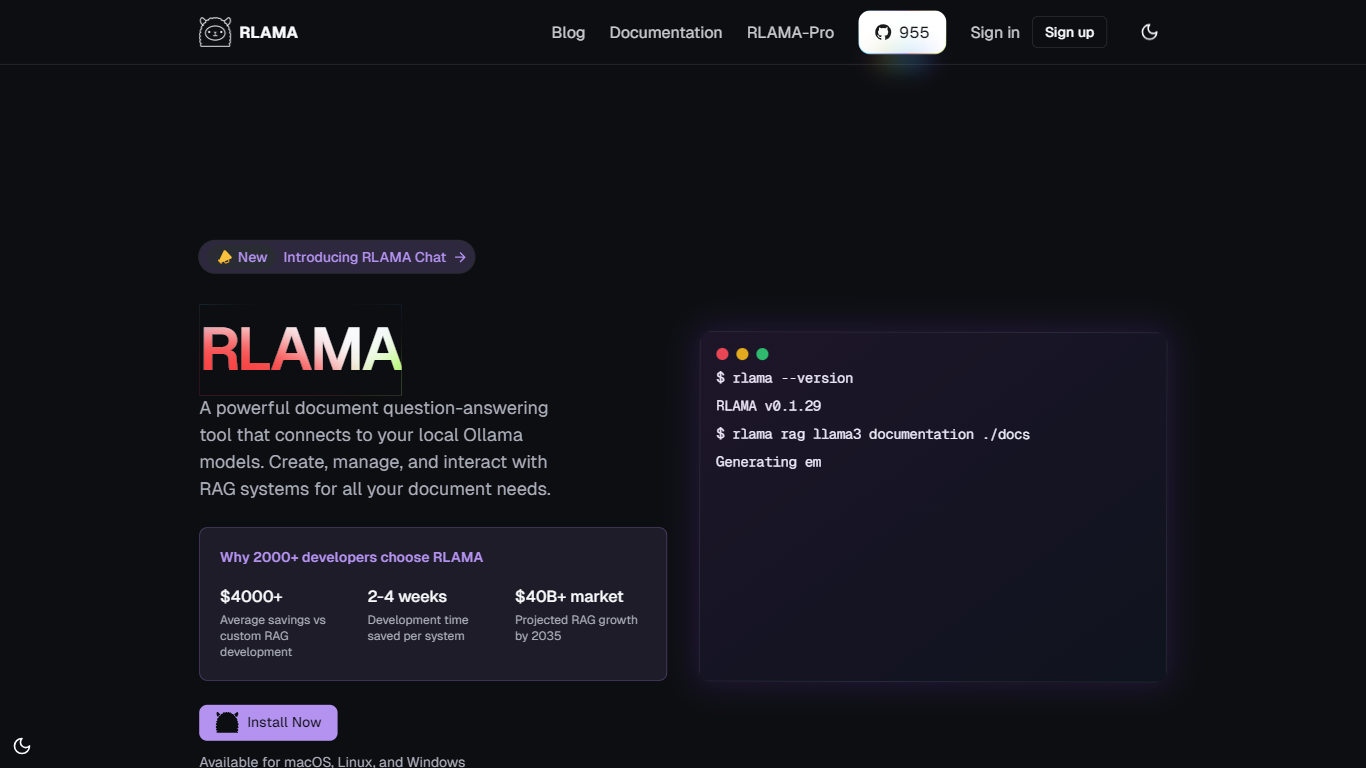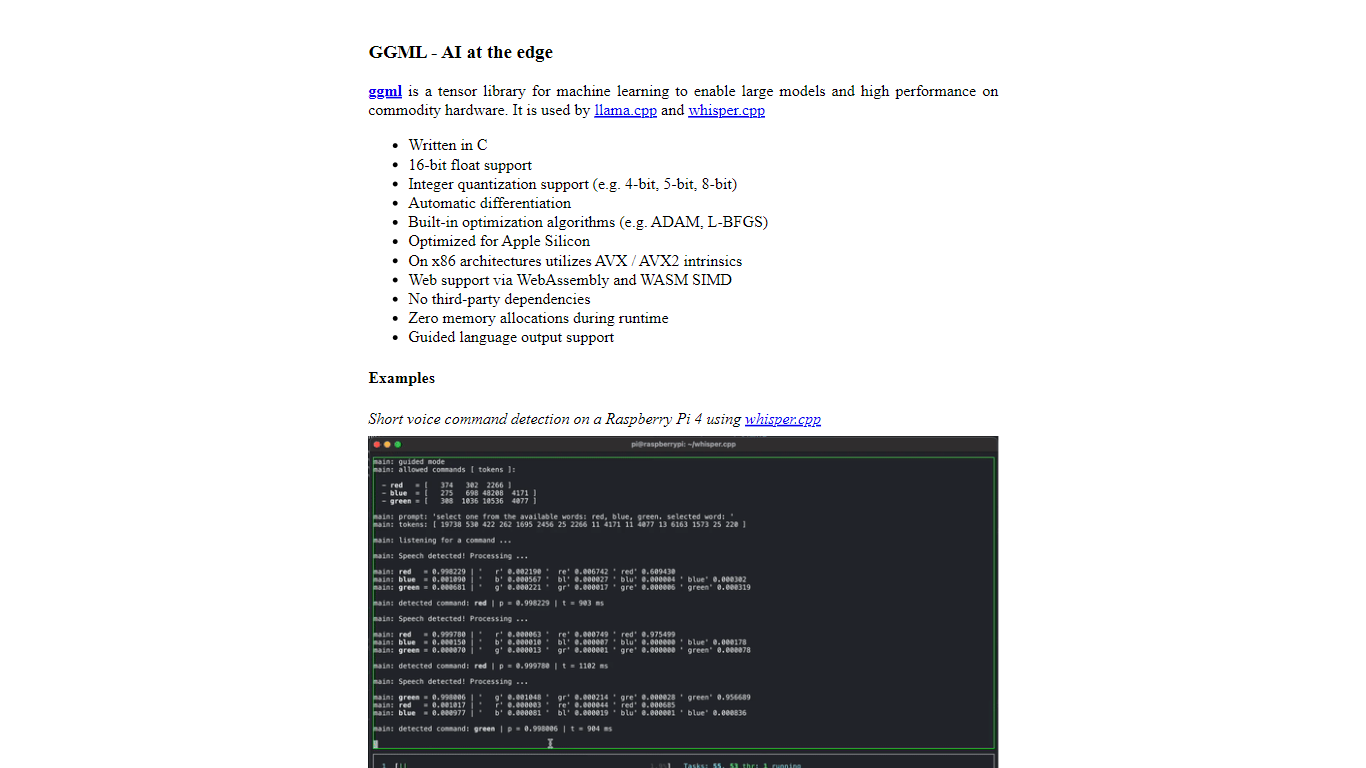RLAMA vs ggml.ai
Explore the showdown between RLAMA vs ggml.ai and find out which AI Large Language Model (LLM) tool wins. We analyze upvotes, features, reviews, pricing, alternatives, and more.
When comparing RLAMA and ggml.ai, which one rises above the other?
When we contrast RLAMA with ggml.ai, both of which are exceptional AI-operated large language model (llm) tools, and place them side by side, we can spot several crucial similarities and divergences. Both tools are equally favored, as indicated by the identical upvote count. You can help us determine the winner by casting your vote and tipping the scales in favor of one of the tools.
Feeling rebellious? Cast your vote and shake things up!
RLAMA

What is RLAMA?
RLAMA is a powerful document question-answering tool designed to connect seamlessly with local Ollama models. It allows users to create, manage, and interact with Retrieval-Augmented Generation (RAG) systems tailored specifically for their documentation needs. The core functionality of RLAMA lies in its ability to provide advanced features that go beyond basic RAG, enabling users to integrate documents effortlessly into their workflows. This makes it an ideal solution for developers and organizations looking to enhance their document management processes.
The target audience for RLAMA includes developers, researchers, and organizations that require efficient document handling and question-answering capabilities. With over 2000 developers already choosing RLAMA, it has proven to be a reliable tool in the market. The unique value proposition of RLAMA is its open-source nature, which allows users to customize and adapt the tool to their specific requirements without incurring high costs associated with custom RAG development.
One of the key differentiators of RLAMA is its offline-first approach, ensuring that all processing is done locally without sending data to external servers. This feature not only enhances privacy but also improves performance by reducing latency. Additionally, RLAMA supports multiple document formats, including PDFs, Markdown, and text files, making it versatile for various use cases. The intelligent chunking feature further optimizes context retrieval, ensuring that users get the most relevant information from their documents.
Technical implementation details highlight that RLAMA is available for macOS, Linux, and Windows, making it accessible to a wide range of users. The tool also offers a visual RAG builder, allowing users to create powerful RAG systems in minutes without the need for coding. This intuitive interface is designed to make RAG creation accessible to everyone, regardless of their technical background. With RLAMA, users can expect to save significant development time and costs while building robust document-based question-answering systems.
ggml.ai

What is ggml.ai?
ggml.ai is at the forefront of AI technology, bringing powerful machine learning capabilities directly to the edge with its innovative tensor library. Built for large model support and high performance on common hardware platforms, ggml.ai enables developers to implement advanced AI algorithms without the need for specialized equipment. The platform, written in the efficient C programming language, offers 16-bit float and integer quantization support, along with automatic differentiation and various built-in optimization algorithms like ADAM and L-BFGS. It boasts optimized performance for Apple Silicon and leverages AVX/AVX2 intrinsics on x86 architectures. Web-based applications can also exploit its capabilities via WebAssembly and WASM SIMD support. With its zero runtime memory allocations and absence of third-party dependencies, ggml.ai presents a minimal and efficient solution for on-device inference.
Projects like whisper.cpp and llama.cpp demonstrate the high-performance inference capabilities of ggml.ai, with whisper.cpp providing speech-to-text solutions and llama.cpp focusing on efficient inference of Meta's LLaMA large language model. Moreover, the company welcomes contributions to its codebase and supports an open-core development model through the MIT license. As ggml.ai continues to expand, it seeks talented full-time developers with a shared vision for on-device inference to join their team.
Designed to push the envelope of AI at the edge, ggml.ai is a testament to the spirit of play and innovation in the AI community.
RLAMA Upvotes
ggml.ai Upvotes
RLAMA Top Features
Simple Setup: Create and configure RAG systems with just a few commands and minimal setup, making it easy for anyone to get started quickly.
Multiple Document Formats: Supports various formats like PDFs, Markdown, and text files, allowing users to work with their preferred document types.
Offline First: Ensures 100% local processing with no data sent to external servers, enhancing privacy and security for sensitive information.
Intelligent Chunking: Automatically segments documents for optimal context retrieval, helping users find the most relevant answers efficiently.
Visual RAG Builder: Create powerful RAG systems visually in just 2 minutes without writing any code, making it accessible to all users.
ggml.ai Top Features
Written in C: Ensures high performance and compatibility across a range of platforms.
Optimization for Apple Silicon: Delivers efficient processing and lower latency on Apple devices.
Support for WebAssembly and WASM SIMD: Facilitates web applications to utilize machine learning capabilities.
No Third-Party Dependencies: Makes for an uncluttered codebase and convenient deployment.
Guided Language Output Support: Enhances human-computer interaction with more intuitive AI-generated responses.
RLAMA Category
- Large Language Model (LLM)
ggml.ai Category
- Large Language Model (LLM)
RLAMA Pricing Type
- Free
ggml.ai Pricing Type
- Freemium
